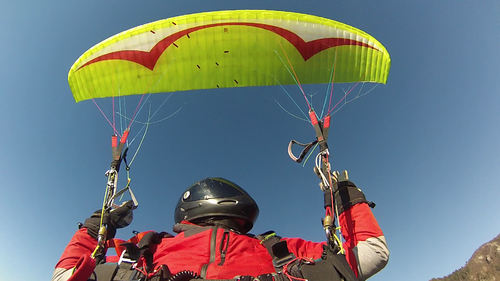Sprint Evo M |
|||||||||||||||||||||||||||||||||||||||||||||||||||||||||||||||||||||||||||||||||||||||||||||||||||||||||||||||||||||||||||||||


|
|||||||||||||||||||||||||||||||||||||||||||||||||||||||||||||||||||||||||||||||||||||||||||||||||||||||||||||||||||||||||||||||
Instability rating |
|||||||||||||||||||||||||||||||||||||||||||||||||||||||||||||||||||||||||||||||||||||||||||||||||||||||||||||||||||||||||||||||
|
|||||||||||||||||||||||||||||||||||||||||||||||||||||||||||||||||||||||||||||||||||||||||||||||||||||||||||||||||||||||||||||||
Glider characteristics |
|||||||||||||||||||||||||||||||||||||||||||||||||||||||||||||||||||||||||||||||||||||||||||||||||||||||||||||||||||||||||||||||
|
Launch preparations: difficult
launch characteristics: dynamic, delayed climb, needs gentle guidance, good feedback during inflation, overshoots, pronounced braking required, accelerates before zenith, control check simple, low takeoff speed
asymmetric collapse: canopy colllapses at high angle to leading edge, moderate dynamics, total course change 270-360°, (4), fast course change rate, moderate forward pitching 45-60°, (2), very high height loss 50-59 m, (4), high sink velocity 20-24 m/s, (3), G-Force < 2,5 G, (1)
Frontal collapse: canopy collapses with high total collapse aera, high pitch backwards >60°, high pitch forwards >60°, high dynamics, course change 90-180°, (3), variable recovery behaviour, at times with stable closed frontal collapse, at times with automatic recovery, (4), usually symmetric recovery, simple pilot action required, (4), delayed return to normal airspeed, short deep stall phase, very high height loss >50 m, (4), moderate sink velocity 15-19 m/s, (2)
Spiral dives: rapid sink velocity increase, Very high G-Force 4,5-5,0 G, (4), Sink velocity after 720° < 22 m/s, (4), Very high maximum sink velocity <25 m/s, (4), sink velocity increase < 6 m/s on brake release, (2), Course change 540-720° after spiral exit, (4), high height loss during recovery 60-100 m, (3)
B-Stall: normal force required, moderate pitch backwards 15-30°, marked pitch forwards 30-45°, unstable sink phase, high deformation tendency, tendency to cravat, immediate return to normal airspeed, 6-8 m/s, height loss on recovery < 20 m
big ears: simple initiation, stable flight phase, wingtips flatter a little, delayed automatic recovery, Vsink unaccelerated 2,5-3 m/s, Vsink accelerated 3,5-4 m/s, Vunaccelerated 0-3 km/h less than trimspeed, Vaccelerated 3-5 km/h faster than trimspeed
Steering behaviour: balanced to agile |
|||||||||||||||||||||||||||||||||||||||||||||||||||||||||||||||||||||||||||||||||||||||||||||||||||||||||||||||||||||||||||||||
Notes |
|||||||||||||||||||||||||||||||||||||||||||||||||||||||||||||||||||||||||||||||||||||||||||||||||||||||||||||||||||||||||||||||
|
Launch Characteristic: The Sprint Evo begins climbing somewhat slowly and then requires a marked brake input to prevent it overshooting at the zenith. Asymmetric Collapse: The Sprint Evo M clearly indicated its positioning in the high-end LTF-B class, with reactions to asymmetric collapses which were more demanding and dynamic that the other (low-end) LTF-B gliders. None of the tested gliders indicated a tendency to cravat after an asymmetric collapse. Front Collapse: The Sprint Evo demonstrated this behavior more severely, after a front collapse the glider tends to horseshoe, then begins to rotate and finally recover asymmetrically. In some cases recovery was only possible through pilot action. Spiral Dive: Sprint Evo pilots must be able to control a spiral via the outer brake and must know how to exit correctly from a stable spiral dive. Spiral dive testing was performed with test pilots sitting in a neutral position. Should weight shifting to the inner side of the spiral be additionally applied, more severe acceleration and exiting reactions are to be expected. Big Ears: Sprint Evo demonstrated slightly delayed exiting. No glider indicated deep or parachutal stall tendencies, even after longer periods of big-ears flying at trim speed. When flown accelerated, all gliders reached at least their normal trim speeds whereas most of them flew slightly faster. B-Stall: B-Stall difficult, marked deformation tendencies. |
|||||||||||||||||||||||||||||||||||||||||||||||||||||||||||||||||||||||||||||||||||||||||||||||||||||||||||||||||||||||||||||||
Rating |
|||||||||||||||||||||||||||||||||||||||||||||||||||||||||||||||||||||||||||||||||||||||||||||||||||||||||||||||||||||||||||||||
|
Safety class 4 This class of paraglider reacts demandingly to one or more of the following manoeuvres: frontal collapse, asymmetric collapse or spiral dive.Demandingly means that the above manoeuvres result in marked dynamic reactions from the glider and/or large height losses. Advanced piloting skills which need to be regularly practised, together with good personal reaction times are required to safely fly this class of gliders. Basic recovery techniques for ending a manoeuvre are not sufficient to maintain control, reduce height loss to a minimum and prevent subsequent critical reactions. Pilots should be able to recognise the onset of the above manoeuvres and be able to prevent or minimise their effects through immediate and precise pilot inputs. Additional experience such as regular ground handling and SIV training is required to safely fly gliders of this class. Special training or pilot skills which exceed standard training may be required for the safe performance of emergency descent techniques. Gliders of this Safety Class are not suitable for beginners, irregular flyers or low-airtime pilots. |
|||||||||||||||||||||||||||||||||||||||||||||||||||||||||||||||||||||||||||||||||||||||||||||||||||||||||||||||||||||||||||||||

